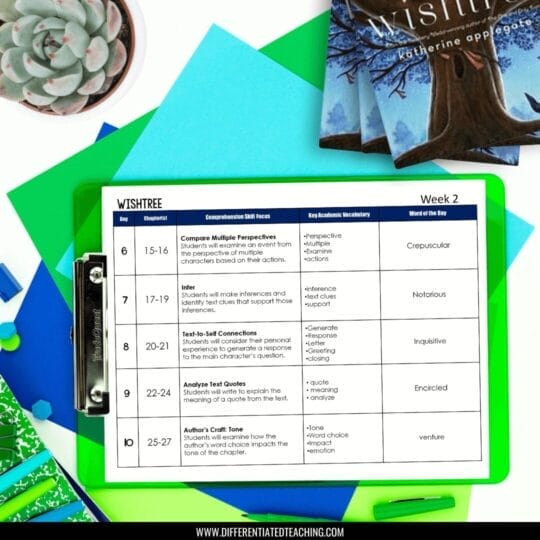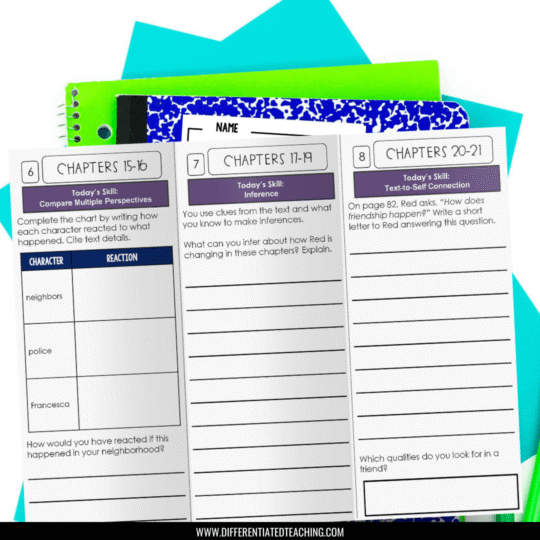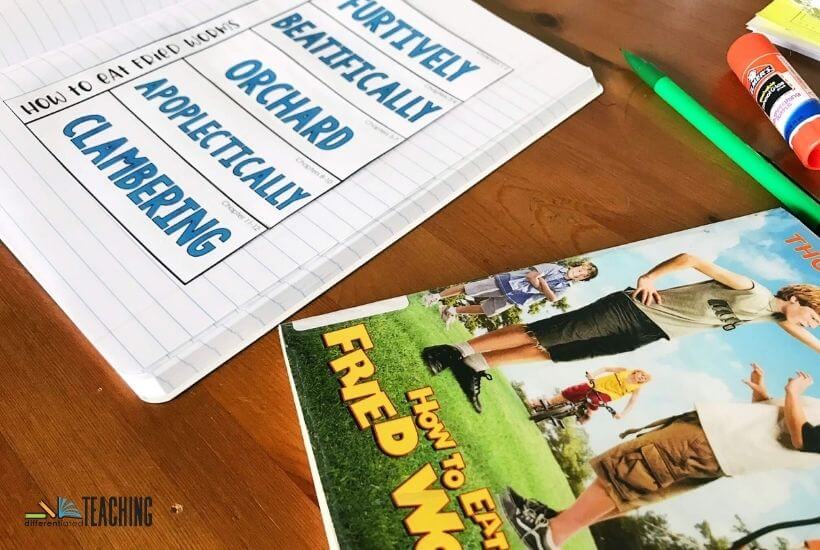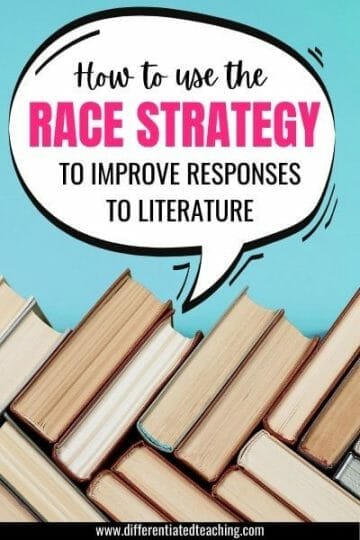Wishtree Novel Study: Lesson Plans, Resources, & Activities
Preparing a Wishtree novel study for your learners? If you’re looking for engaging novel study resources for Wishtree that aren’t just a boring list of chapter comprehension questions, you’ve come to the right place. In this post, I’ll share resource recommendations, free teaching ideas to kick off and wrap up your book unit, and some helpful information about the book. By the time you’re done, you’ll have everything you need to implement an amazing novel study unit using this text that students love!

Wishtree Summary
Standing tall for centuries, Red the oak has witnessed the bustling life of a neighborhood unfold beneath its branches. But Red isn’t your average tree. He’s a wishtree, adorned with whispered hopes and dreams on scraps of fabric and forgotten socks. From a young girl yearning for a friend to a family grappling with prejudice, Red listens silently, offering solace and a silent promise that wishes might just take flight.
However, the arrival of a new family disrupts the peaceful hum of the neighborhood. Tensions rise, and the very notion of a wishtree is challenged. Can Red, with the wisdom of his countless rings, bridge the divides and remind everyone of the power of hope, community, and the magic that blooms when wishes intertwine?
Dive into the heartwarming story of Wishtree and discover how a silent observer becomes a beacon of connection in a world that desperately needs it.
Pre-Reading & Post-Reading Ideas to Engage Learners in Your Wishtree Novel Study
Finding engaging activities before and after your novel study can make a huge difference in student buy-in and recall. I wanted to share some of my favorite free and low-cost activities to use with Wishtree to make your unit memorable for learners.
Pre-Reading Activities for Wishtree: Spark Curiosity and Empathy
Before reading lay the groundwork for the unforgettable experience that awaits your readers. The pre-reading phase of your novel unit is an opportunity to ignite curiosity, spark imaginations, and build anticipation for the wondrous tale that lies ahead. Therefore, choosing an engaging pre-reading activity is an important part of getting readers excited about the book.
Since the book offers many opportunities for connecting to social-emotional learning, you’ll find ways to help your students tune into their own hopes and dreams and the perspectives of others through pre-reading options. Here are 3 super fun activities that promise to captivate your learner’s attention and get students in the right frame of mind for your Wishtree novel study.
- Wishing on a Leaf (10 minutes):
- Provide students with construction paper leaves or have them cut their own from green paper.
- Explain the concept of a “wishtree” – a tree where people tie wishes on ribbons or leaves.
- Play calming music and ask students to close their eyes and think about a personal wish (big or small).
- Have them write their wish on their paper leaf and decorate it with drawings or symbols.
- Students can share their wishes with the class (optional) or simply reflect on their hopes and dreams.
- Animal Encounters (15 minutes):
- Divide the class into small groups and assign them a different animal that might live near a wishtree (squirrels, crows, owls).
- Each group researches their animal – its habitat, behaviors, and how it might interact with a tree.
- Students can create a short skit or drawing depicting their animal encountering the wishtree and observing the wishes left behind.
- The “What If?” Discussion (10 minutes):
- Discuss the concept of eavesdropping – secretly listening to someone’s conversation.
- Ask students if they think it’s okay for a tree to “eavesdrop” on people’s wishes.
- Would it be interesting or intrusive?
- Encourage a debate about the potential benefits and drawbacks of the wishtree being able to hear everyone’s wishes.
These quick and easy introductory activities are sure to spark curiosity about the book’s premise, the characters who might interact with the wishtree, and get students thinking about the themes of the story as you prepare to dive into your novel unit.
Post-reading Activities for Wishtree: More than just a boring book report
After your novel study, it can be fun to add an activity or two to wrap up the experience for learners. These post-reading activities are designed to extend Wishtree beyond the reading experience, allowing students to immerse themselves in the wizarding world through hands-on projects, interactive challenges, and creative endeavors that make connections.
Here are 12 fun post-reading activities you can add to your lesson plans after you wrap up your novel study:
- The Wishing Wall Mural (Artistic/Collaborative):
- Create a large mural on a classroom wall or bulletin board.
- Students can draw or paint a representation of the wishtree in the center.
- Around the tree, they can include images of characters from the story, their wishes, and how those wishes might have played out.
- This collaborative mural allows them to visually retell the story and explore the characters’ journeys.
- The Animal Alphabet of Wishes (Written/Kinesthetic):
- Assign each student a letter of the alphabet.
- Their task is to write a short poem (acrostic poem) about a character or animal from the book, incorporating their wish and personality.
- For example, for “B” they could write about Bongo the crow and his wish for a shiny new object.
- Students can illustrate their poems and display them together as a colorful “Animal Alphabet of Wishes.”
- The “Dear Red” Letter (Written/Reflective):
- Imagine you’re writing a letter directly to Red, the wise old oak tree.
- Students can thank Red for listening to their wishes, share their thoughts on the stories they heard, or ask Red questions about his long life and experiences.
- Encourage them to use descriptive language and capture the voice of their chosen character.
- The “Wishtree News” (Written/Creative):
- Create a mock newspaper issue titled “The Wishtree News.”
- Students can write articles from different perspectives – a squirrel reporting on the latest neighborhood gossip, an owl offering philosophical musings on wishes and dreams, or even a human news reporter interviewing Red about the stories he’s heard.
- Include illustrations and catchy headlines to make the newspaper visually engaging.
- beloved wizarding sport.
- The “Wishes Don’t Always…” Play (Kinesthetic/Verbal):
- Divide the class into small groups and assign them a wish from the book.
- Each group writes and performs a short playlet showcasing what might happen if the wish comes true, but in an unexpected or humorous way.
- Encourage creativity and improvisation to explore the potential downsides or twists associated with wishes being granted.
- The “After the Wish” Comic Strip (Artistic/Sequential):
- Choose a character or wish from the book.
- Students create a comic strip depicting what happens after the character receives their wish (positive or negative outcomes).
- Encourage them to use humor, suspense, or emotional storytelling to capture the consequences of getting what you wished for.
- The Empathy Web (Visual/Reflective):
- Choose a character who interacted significantly with the wishtree.
- Students create a web diagram with the character’s name in the center.
- On each branch, they write down events, wishes, or interactions from the story that impacted the character’s growth or understanding.
- Encourage them to use arrows to show connections between different events and how they shaped the character’s journey.
- The Wishing Well Debate (Verbal/Social):
- Divide the class into two groups – “pro-wishtree” and “anti-wishtree.”
- The “pro-wishtree” group argues for the benefits of having a tree that listens to wishes and offers comfort.
- The “anti-wishtree” group argues for the potential downsides, such as false hope or the intrusion of privacy.
- Students can research real-life traditions of wishing on objects or at specific locations to support their arguments.
- Hold a class debate to explore the complex role of wishes and the wishtree’s influence.
- The “What if Red Could Talk?” Interview (Written/Critical Thinking):
- Imagine Red, the wishtree, can finally speak.
- Students write interview questions for Red, focusing on his observations of human nature, the evolution of the neighborhood, and the impact of wishes on people’s lives.
- Encourage them to ask thoughtful questions that delve deeper into the book’s themes and Red’s unique perspective.
- The “Wishtree Wisdom” Journal (Written/Creative):
- Create a journal entry from the perspective of Red.
- Students can reflect on the most significant wishes he’s heard, the lessons he’s learned about human nature, and his hopes for the future of the neighborhood.
- Encourage them to use figurative language and descriptive details to capture Red’s voice and wisdom.
- The “Modern Wishtree” Project (Research/Collaborative):
- Research real-life wishing traditions from different cultures (wishing wells, throwing coins into fountains, tying ribbons to trees).
- Divide the class into groups and assign them a specific culture.
- Each group creates a presentation or infographic explaining the tradition, its significance, and how it connects to the themes of Wishtree.
- Students can then discuss the universality of wishing and how it reflects human desires and hopes.
- The “Beyond the Wishtree” Story (Written/Interpersonal):
- Choose a character from the book who interacted with the wishtree.
- Write a short story depicting what happens to that character in the future.
- Did their experience with the wishtree change their perspective on wishes or their approach to life?
- Students can explore themes of personal growth, dealing with challenges, and the importance of community.
Wishtree Study Guide
So we’ve covered what you might do before and after your Wishtree novel study, but what about the actual unit itself?
Each of my over 300 novel units comes with an instructional guide to help you quickly and easily plan your daily lessons. In addition, you’ll find the PDF printables to help you cover the key reading comprehension skills and vocabulary associated with the text in a student-friendly format that won’t overwhelm learners.

This Wishtree novel study includes everything you need for a four-week (20-day) novel unit designed to focus on a single comprehension skill and text-based vocabulary word each day to maximize student learning. Here’s a taste of what’s included in this novel unit:
What’s included in this novel study unit?
Reading comprehension skills and strategies addressed:
A single daily response focus helps you plan for meaningful instruction and review. Rather than bouncing between 5 different skills at a surface level, you can focus on a single skill at a deeper level to ensure students truly understand and can apply this to their reading.
Here are some of the daily comprehension focus skills covered in the Wishtree book unit:
- Text analysis and responding to literature
- Exploring how character development and change occurs through events of the plot
- Making inferences and drawing conclusions based on text clues
- Analyzing point of view & its impact on the reader.
- Summarizing and identifying the main idea of large and small passages of text
- Identifying cause and effect relationships
- Interpreting theme

Sample of Text-Based Vocabulary Studied through this Novel Unit:
The instructional guide outlines both academic vocabulary students need to know to respond to the comprehension/discussion question of the day and the daily text-based vocabulary word students will study each day.

Here are just a few of the text-based vocabulary words students learn through this Wishtree novel study unit:
- aspiration
- endure
- crepuscular
- melancholy
- indignation
- deluge
Purchase the Wishtree Novel Study and Get Instant Access
When you purchase the Wishtree Novel Study PDF from Differentiated Teaching, you’ll receive all the following resources in a downloadable format:

- Daily comprehension prompts in 2 formats for differentiation
- Foldable trifold brochures
- Cut & paste journal prompts for interactive notebooks
- Weekly word of the day flip books for text-based vocabulary
- Easy-to-follow directions for printing & prep
- Instructional planning guide
- Answer keys
More About the Book
What is the reading level of this text?
Since different schools use different leveling programs, here is the information about the book for the most commonly used programs. This can help you decide if a Wishtree novel study is right for your readers, or if the book might be better for a read aloud.
- Grades: 3-5
- Guided Reading Level: T
- Lexile Level: 590L
- Accelerated Reader: 4.2
How many pages is the book? Chapters?
The paperback version of Wishtree is 240 pages long. It has 51 total chapters.
What genre is the text? Any concerning themes to be aware of?
Wishtree falls primarily under the genre of middle-grade fiction. It also incorporates elements of realistic fiction, as the story takes place in a contemporary neighborhood setting and deals with relatable experiences like friendship, family challenges, and cultural differences.
Here are some themes to be aware of, but none are presented in a way that would be overly concerning for most audiences:
- Prejudice and Discrimination: The story touches on the theme of prejudice faced by a new family who immigrated to the neighborhood. It’s handled sensitively and explores the importance of acceptance and understanding.
- Loss and Grief: A character experiences a personal loss, and the story explores themes of grief and finding comfort in unexpected places.
- Environmental Issues: The book briefly mentions the potential threat of the wishtree being cut down, sparking conversations about the importance of protecting trees and nature.
Overall, Wishtree is a heartwarming story that promotes themes of hope, community, and the power of wishes. While it touches on some potentially sensitive topics, it does so in a way that is age-appropriate for middle-grade readers and can be a springboard for thoughtful discussions.








